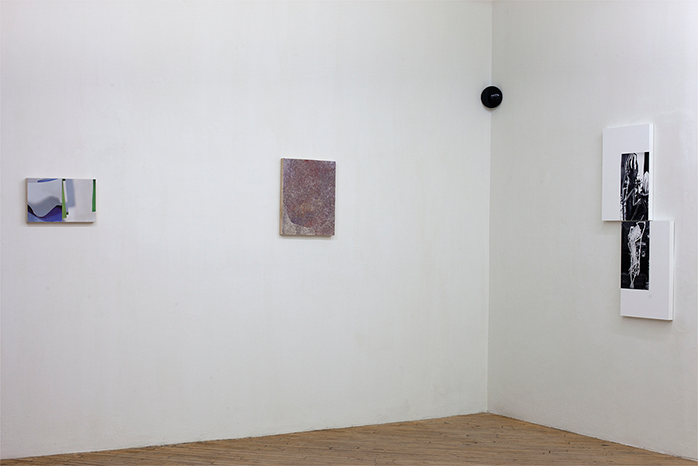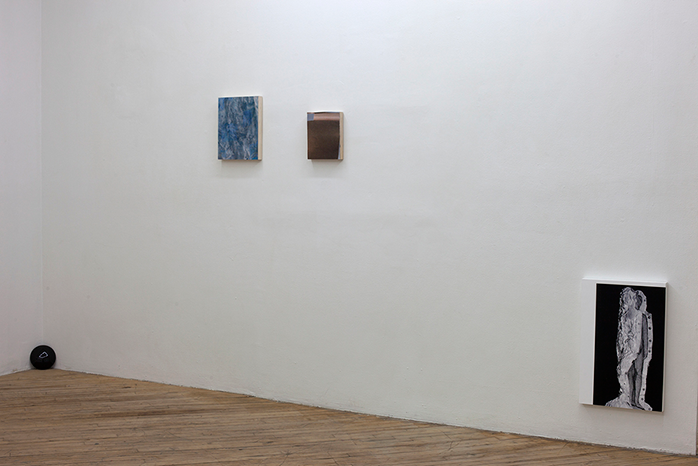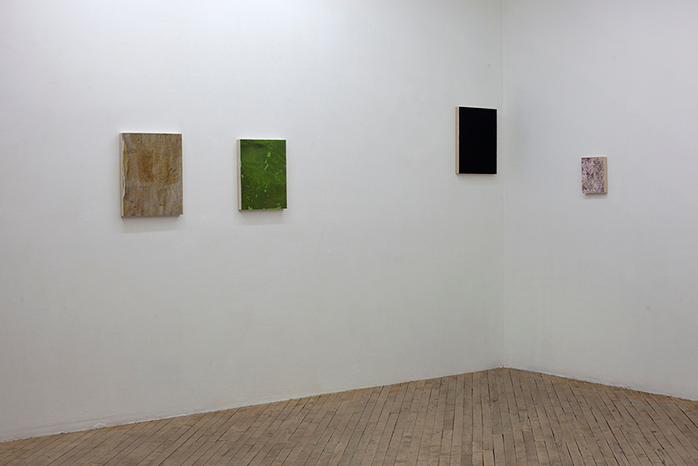GraceMarie Keaton at Vox Populi

(IMAGE: Installation view of Vitreous. CREDIT: Courtesy of the artist)
CHRISTOPHER GIANUNZIO: What was the process that lead you to this exhibition at Vox Populi?
GRACEMARIE KEATON: For this show, I was interested in further exploring the picture plane as a sight of projection for the viewer. In the past, my work has been more specific to the medium of photography –of it’s limits and possibilities, it’s mechanisms, and history. During the past couple of years my practice has expanded outward- incorporating my other interests, in particular writing and collage. With vitreous, the ideas have expanded to all types of images and the processes of viewing: the sense of images, the sense of otherness and separation (as well as intimacy) from subject to object. With this installation I hoped to slow the experience down, to make viewing a process of mediation, or suspension. Like slowing on a turntable. The show was informed by my preoccupations with vision as an act of touch, glass, mediation, reproductions, and images.
CG: Can you explain a little about the structure of your show at Vox? Many types of imagery exist in the installation, tell us a little about the semiotics at play in the show?
GK: In organizing the show I wanted to create a rhythm by stripping away certain senses (a visual ground for instance, or a recognizable subject matter) then reintroduce them. – in an attempt at making disorientation more comfortable. The pieces all have a different sense of groundedness and I tried to anchor the viewer in the space with them as well as create a sense of continuation like waves, through visual rhyming.
While the imagery in the show is visually disparate, to me they weave a loose narrative of containment and permeability, separation and proximity. Each casting the other in relief, a kind of visual foil. They have all undergone some form of translation or process that changes their surface or form. A means of further mediation I hope to bring their conceptual qualities up to their surface and tease out new ones. The source image for sight sown is a photograph a friend shared with me of her bedroom window. In it, the wind had pulled her heavy curtain tautly through the window. I took this image and sanded down the ink, then rubbed the ink debris back into the newly textured surface. The refigured image, made up of all the points of light that once described her window, left no intelligible subject.
The exhibition is comprised of photographs depicting sculptural processes, photographic sweeps –cut from reproductions of sculpture, cheesecloths I’ve used in making anthotypes an image of rotted flowers from the internet. They are each individual parts that assemble to one.

(IMAGE: SightSown, collaged inkjet prints on panel, 18″ x 24″, 2015. CREDIT: Courtesy of the artist)
CG: How do you feel performance relates to your use of the photographic plane, can you speak to how much or little you think performance functions in relationship to the audience?
GK: In my mind, looking at an image is an act of participation and in a certain sense, performative. We bring ourselves to all things. As an audience, our subjectivity informs our perceptions and experiences. I want to suspend people in those moments of exchange between themselves and the picture plane.
CG: What kind of experience do you want your audience to have?
GK: I want an audience to have a meditative experience utilizing visual sensations, red herrings, a peaceful disorientation. One that evokes the picture plane; both as a space to enter the images, all the while simultaneously being kept out. This is where the balance of representation and abstraction come into play. In it you float between two states and ideally feel yourself amongst it. Floating in the jelly!

(IMAGE: Installation view of Vitreous. CREDIT: Courtesy of the artist)
CG: What do you define as the studio? Is it a mental space? Is it a physical space for you?
GK: It can be both. I don’t have a definition of a studio. Ideally, we are all living receptively to what’s going on around us and responding to it. That’s what the studio has come to mean, right?
CG: Where is the origin of the representational imagery and the sculptural elements?
GMK: In fact, all of the works come from representational imagery –only some stay representational. The most obvious being the photographs depicting bodily casting and relief processes. These come from a salvaged textbook about figurative sculpture. I was interested in the idea of bodies forming bodies as a kind of tactical vision. Knowing how an arm feels, sets, rest, weighs, and duplicating that using your own. Our body is our only means of connecting and moving in the world or bridging the gap between our inner lives and outer. They are a skin, a barrier, and a method of containment.
CG: How do you feel the strategy of appropriation fits within your process as an artist (or not?) Do you think this is a valid way of evaluating the current circumstances of image culture?
GK: That’s a huge question. I do appropriate in my practice. In a certain sense, it is integral to the work- but it’s not about the act- it’s about the material; the images that are collected. Sometimes, as with constitute (arm and leg) they are left relatively untouched, other times I’m interested in the shape of the subject, or its texture. I like to work with what is already in circulation, or used to be. It’s a starting point or a common visual currency between myself and a viewer (not that I am separate). My appropriation is more of an outcome of circumstance, of so much information being available all the time.
CG:Where did the poems on your exhibition page come from?
GK: There are two poems in the exhibition page. One is a selection of writing that I worked on while making the pieces in the installation. I’ve recently begun a backwards writing process for my work. I will start very intuitively writing in the studio around the work and the materials then re-interpret the poem over and over until the language becomes more concrete and communicative. I’m interested in the process of description and translation. I wanted to try to create the experience of seeing the work through text as a means to better understand it.
The second is a photographed poem; it comes from Cole Swensen’s extended poem The Glass Age. I spent a lot of time with this book while making the work for vitreous. The selection in the photograph is fitting for its evocation of multiple axis’ of experience while still separated by a glass pane, or a picture plane.

(IMAGE:Installation view of Vitreous. CREDIT: Courtesy of the artist)
CG: What are some of your upcoming projects? What are you working on now??
GK: Currently I am putting together a show in Minneapolis with two of my peers- Benjamin Heyer and Katelyn White. I am also working on a couple of new pieces: excited by the experience of exceeding your eye’s dynamic range. Definitely a product of the Philadelphia sunlight!
Christopher Gianunzio is an artist and curator based in Philadelphia and is currently the Director of the Art Gallery and the Sarnoff Collection at the College of New Jersey. He has organized exhibitions including the work of Adam Broomberg & Oliver Chanarin, Alyse Emdur, La Toya Ruby Frazier, Luis Gispert, Beate Gütschow, Greg Halpern, Ron Jude, Christian Patterson, Taryn Simon, Chad States, Mark Steinmetz and Ofer Wolberger. Previously he worked as the Assistant Director of the Philadelphia Photo Arts Center where he founded the Philadelphia Art Book Fair. He is currently a member of Vox Populi.
…
GraceMarie Keaton: Vitreous
cargocollective.com/gracemariekeaton
ON VIEW: November 6-29, 2015
Vox Populi
319 North 11th Street, 3rd Floor
Philadelphia, PA 19107
voxpopuligallery.org
